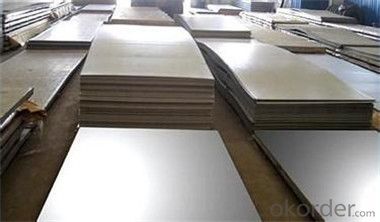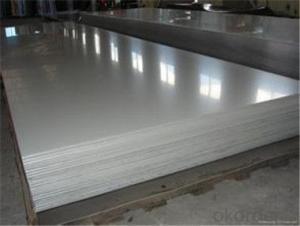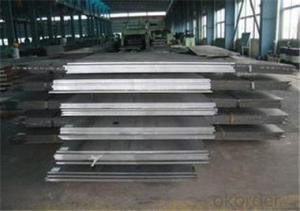Stainless Steel Sheet AISI 316 with Best Quality in China
- Loading Port:
- Tianjin
- Payment Terms:
- TT OR LC
- Min Order Qty:
- 50 m.t.
- Supply Capability:
- 45555555 m.t./month
OKorder Service Pledge
OKorder Financial Service
You Might Also Like
Item specifice
Description of stainless steel plate:
316L stainless steel containing molybdenum species, the steel containing molybdenum, the overall performance is better than steel 310 and 304 stainless steel, high temperature conditions, when the sulfuric acid concentration is less than 15% or greater than 85%, 316L stainless steel with a wide range of purposes. 316L stainless steel also has good resistance to chloride corrosion performance, it is usually used in the marine environment.
Festures of stainless steel plate:
| Packaging Details: | standard packing to export 4 eye bands and 3 circumferential bands in steel, galvanized metal fluted rings on inner and outer edges, galvanized metal & waterproof paper wall protection disk, galvanized metal & waterproof paper around circumference |
| Delivery Detail: | 15-25 days after received your deposit or to your quantity |
Specifications of stainless steel plate:
Product Name | cr 1219x2438 stanless steel sheet 201 |
standared | JIS, AISI, ASTM, GB, DIN,SUS |
Thickness | 0.2mm~2.5mm |
Size | 1000*2000mm,1219*2438mm or as per customers' request |
Surface finish | 2B, BA, Hair Line, No.1,No.4, Mirror Finish |
Application | Kitchenware, decoration construction and building ornament, product parts manufacturing and stainless steel products tooling and so on |
Payment terms | T/T 30% for deposit, Balance against the copy of B/L; or L/C at sight |
Product Packing | wooden pallet |
Delivery time | within 15-20 working days after we got your 30% deposit |
Attention | FREE SAMPLES can be sent on request. |
Images of stainless steel plate:

FAQ:
1. What is your package?
Packing situation: standard seaworthy packing or as customer required.
2. How long is the lead time?
Delivery time: 45 days after order confirmed.
3. What payment term do you accept?
Payment: T/T or L/C at sight.
- Q:What are the advantages of using steel wire rod in concrete reinforcement?
- The advantages of using steel wire rod in concrete reinforcement include increased tensile strength, better durability, enhanced load-bearing capacity, improved resistance to cracking and shrinkage, and increased overall structural integrity. Steel wire rods also provide flexibility, ease of handling, and cost-effectiveness in construction projects.
- Q:How does the fatigue strength of steel wire rod vary with different diameters?
- The fatigue strength of steel wire rod generally decreases as the diameter of the rod increases.
- Q:How is steel wire rod used in the production of wire mesh?
- Wire mesh production relies heavily on steel wire rod, which serves as a vital component. This versatile material, also known as wire cloth or wire fabric, finds application in numerous industries for various purposes. To initiate the wire mesh production, steel wire rod undergoes hot rolling, a process wherein molten steel is passed through rollers to form a continuous, elongated rod with a specific diameter. The diameter of the steel wire rod may vary based on the desired end product and application of the wire mesh. After the production of steel wire rod, it is drawn through dies to further reduce its diameter. This drawing process not only reduces the diameter but also enhances the wire's tensile strength and surface finish. Consequently, the drawn wire becomes suitable for utilization in wire mesh production. The wire mesh machine is responsible for processing the steel wire rod. It undergoes a series of procedures to form the wire mesh. Initially, the wire is straightened and cut to the required length. These cut wire lengths are then fed into a weaving machine, where they are interwoven to create the desired mesh pattern. The wire mesh machine employs various techniques, including plain weave, twill weave, or Dutch weave, to manufacture different types of wire mesh. The steel wire rod functions as the fundamental building block for these patterns, providing the necessary strength and durability for the wire mesh to withstand diverse applications. Once the wire mesh is woven, it proceeds through additional processes, such as galvanizing or coating, to enhance its properties. Galvanizing involves applying a zinc coating to protect the wire mesh from corrosion, while coating can provide additional attributes such as heat resistance, chemical resistance, or abrasion resistance. In conclusion, steel wire rod plays a vital role in wire mesh production. It serves as the starting material, undergoes processing and weaving to create various wire mesh patterns, and offers the requisite strength and durability for applications across different industries.
- Q:What is the average diameter of steel wire rod?
- The average diameter of steel wire rod varies depending on its intended application and industry standards. However, it typically ranges from 5.5 millimeters to 14 millimeters.
- Q:How is steel wire rod used in the production of tire reinforcement materials?
- Steel wire rod is used in the production of tire reinforcement materials as it provides strength and durability to the tires. The wire rods are typically embedded in the tire's rubber compound, forming a strong and flexible structure that helps to support the tire's tread and sidewalls. This reinforcement helps to enhance the tire's overall performance, including its resistance to punctures, stability, and traction on the road.
- Q:What are the different rolling processes used for steel wire rod production?
- Steel wire rod production utilizes various rolling processes, each with its own merits and uses. 1. The most prevalent and widely employed method is hot rolling. This entails heating steel billets to high temperatures and passing them through rolling mills. Hot rolling yields a more malleable and flexible wire rod, making it suitable for applications in construction, automotive, and manufacturing industries. 2. In contrast, cold rolling involves rolling the wire rod at room temperature. This process enhances the wire rod's surface finish and dimensional accuracy. Additionally, it improves the mechanical properties, enabling its use in specialized applications such as high-strength wires, springs, and electrical conductors. 3. Continuous casting and rolling combine the casting and rolling processes into a seamless operation. Molten steel is directly cast into thin slabs or billets, which are then rolled into wire rods without intermediate reheating. This integration offers advantages like enhanced efficiency, reduced energy consumption, and improved product quality. 4. Microalloying rolling incorporates small amounts of alloying elements into the steel composition to enhance its strength and other mechanical properties. This method is commonly employed in the production of high-strength wire rods for construction, infrastructure, and automotive industries. 5. Thermomechanical rolling employs a combination of hot rolling and controlled cooling to achieve specific mechanical properties. By manipulating the cooling rate, the microstructure of the wire rod can be altered, resulting in improved strength, toughness, and formability. This process is often utilized in the production of high-quality wire rods for critical applications such as suspension cables, ropes, and steel reinforcement. In conclusion, the choice of rolling process for steel wire rod production depends on factors such as desired mechanical properties, surface finish, and application requirements. Each process provides distinct advantages, enabling manufacturers to tailor wire rods to specific applications.
- Q:How is steel wire rod used in the production of springs?
- Steel wire rod is used in the production of springs as it serves as the raw material for manufacturing spring wires. The wire rod undergoes a series of processes such as drawing, annealing, and tempering to transform it into high-quality spring wires with specific characteristics. These spring wires are then utilized in various applications, including automotive, aerospace, and industrial sectors, where they provide resilience and elasticity to the springs, allowing them to absorb and release energy efficiently.
- Q:What are the different types of steel wire rod surface defect identification techniques?
- There are several different types of steel wire rod surface defect identification techniques, including visual inspection, magnetic particle inspection, eddy current testing, ultrasonic testing, and dye penetrant testing. Each technique has its own advantages and limitations, and the choice of method depends on factors such as the type and size of defects to be detected, the production environment, and the level of accuracy required.
- Q:How are steel wire rods used in the manufacturing of welding wires?
- Steel wire rods are commonly used as the primary raw material in the manufacturing of welding wires. These rods are typically drawn through a series of dies to achieve the desired diameter and shape for the welding wire. The steel wire rods provide strength, durability, and conductivity to the final welding wire, ensuring reliable performance during welding processes.
- Q:How is steel wire rod used in the manufacturing of wire brushes?
- Steel wire rod is used in the manufacturing of wire brushes as it serves as the raw material for the bristles or filaments of the brush. The wire rod is transformed into fine wires, which are then twisted, knotted, or crimped to form the brush bristles. These bristles are attached to a handle or base to create wire brushes that are widely used for cleaning, polishing, and surface preparation in various industries and household applications.
1. Manufacturer Overview |
|
|---|---|
| Location | |
| Year Established | |
| Annual Output Value | |
| Main Markets | |
| Company Certifications | |
2. Manufacturer Certificates |
|
|---|---|
| a) Certification Name | |
| Range | |
| Reference | |
| Validity Period | |
3. Manufacturer Capability |
|
|---|---|
| a)Trade Capacity | |
| Nearest Port | |
| Export Percentage | |
| No.of Employees in Trade Department | |
| Language Spoken: | |
| b)Factory Information | |
| Factory Size: | |
| No. of Production Lines | |
| Contract Manufacturing | |
| Product Price Range | |
Send your message to us
Stainless Steel Sheet AISI 316 with Best Quality in China
- Loading Port:
- Tianjin
- Payment Terms:
- TT OR LC
- Min Order Qty:
- 50 m.t.
- Supply Capability:
- 45555555 m.t./month
OKorder Service Pledge
OKorder Financial Service
Similar products
New products
Hot products
Related keywords



























